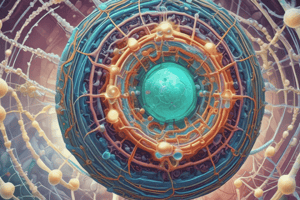Podcast
Questions and Answers
What is the goal of tissue engineering?
What is the goal of tissue engineering?
- Creating biologically inactive scaffolds
- Assembling functional constructs to restore damaged tissues or organs (correct)
- Studying the body's self-healing mechanisms
- Developing synthetic materials for medical use
Which of the following is an example of an engineered tissue approved by the FDA?
Which of the following is an example of an engineered tissue approved by the FDA?
- Artificial skin (correct)
- Biologically inactive scaffolds
- Chemically treated muscle tissue
- Synthetic bone marrow
What does regenerative medicine encompass in addition to tissue engineering?
What does regenerative medicine encompass in addition to tissue engineering?
- Development of synthetic organs
- Study of infectious diseases
- Investigation of genetic disorders
- Research on self-healing and use of foreign biological material (correct)
How are the terms 'tissue engineering' and 'regenerative medicine' related?
How are the terms 'tissue engineering' and 'regenerative medicine' related?
What are the key components combined in tissue engineering?
What are the key components combined in tissue engineering?
What is the primary focus of tissue engineering?
What is the primary focus of tissue engineering?
What distinguishes regenerative medicine from tissue engineering?
What distinguishes regenerative medicine from tissue engineering?
Why are artificial skin and cartilage mentioned in the context of tissue engineering?
Why are artificial skin and cartilage mentioned in the context of tissue engineering?
Why have the terms 'tissue engineering' and 'regenerative medicine' become largely interchangeable?
Why have the terms 'tissue engineering' and 'regenerative medicine' become largely interchangeable?
What is the ultimate goal of regenerative medicine?
What is the ultimate goal of regenerative medicine?
Flashcards
What is the Goal of Tissue Engineering?
What is the Goal of Tissue Engineering?
Assembling functional constructs to restore damaged tissues or organs.
Regenerative Medicine
Regenerative Medicine
Engineering the body’s own cells and systems to repair damage.
Artificial skin
Artificial skin
A type of engineered tissue approved by the FDA, used to replace damaged skin.
Tissue engineering
Tissue engineering
Signup and view all the flashcards
Scaffold
Scaffold
Signup and view all the flashcards
Cells
Cells
Signup and view all the flashcards
Biologically active molecules
Biologically active molecules
Signup and view all the flashcards
Self healing in Regenerative Medicine
Self healing in Regenerative Medicine
Signup and view all the flashcards
Use of Foreign Biological Material in Regenerative Medicine
Use of Foreign Biological Material in Regenerative Medicine
Signup and view all the flashcards
Relationship between Tissue Engineering and Regenerative Medicine
Relationship between Tissue Engineering and Regenerative Medicine
Signup and view all the flashcards
Study Notes
Tissue Engineering and Regenerative Medicine
- The goal of tissue engineering is to create functional tissue substitutes that can replace or repair damaged or diseased tissues and organs.
Examples of Engineered Tissues
- One example of an engineered tissue approved by the FDA is a skin substitute.
Regenerative Medicine
- Regenerative medicine encompasses tissue engineering, as well as self-healing and the stimulation of the body's own repair mechanisms.
Relationships between Terms
- Tissue engineering is a subset of regenerative medicine.
- The terms 'tissue engineering' and 'regenerative medicine' are related and often used interchangeably.
Key Components of Tissue Engineering
- The key components combined in tissue engineering are biomaterials, cells, and biochemical factors.
Focus of Tissue Engineering
- The primary focus of tissue engineering is to develop functional substitutes for damaged tissues and organs.
Distinguishing Regenerative Medicine
- Regenerative medicine distinguishes itself from tissue engineering by focusing on the stimulation of the body's own repair mechanisms, in addition to tissue engineering.
Artificial Skin and Cartilage
- Artificial skin and cartilage are mentioned in the context of tissue engineering as examples of engineered tissues that can replace or repair damaged tissues.
Interchangeable Terms
- The terms 'tissue engineering' and 'regenerative medicine' have become largely interchangeable due to their overlap in goals and approaches.
Goal of Regenerative Medicine
- The ultimate goal of regenerative medicine is to restore or establish normal function in damaged or diseased tissues and organs.
Studying That Suits You
Use AI to generate personalized quizzes and flashcards to suit your learning preferences.




